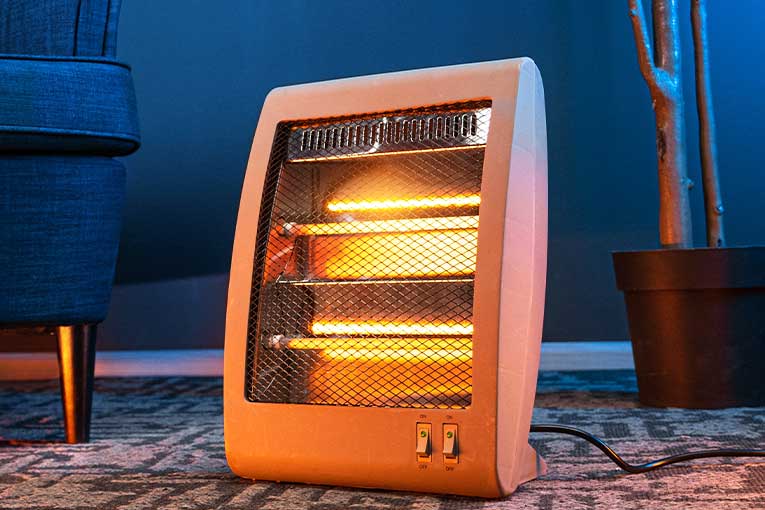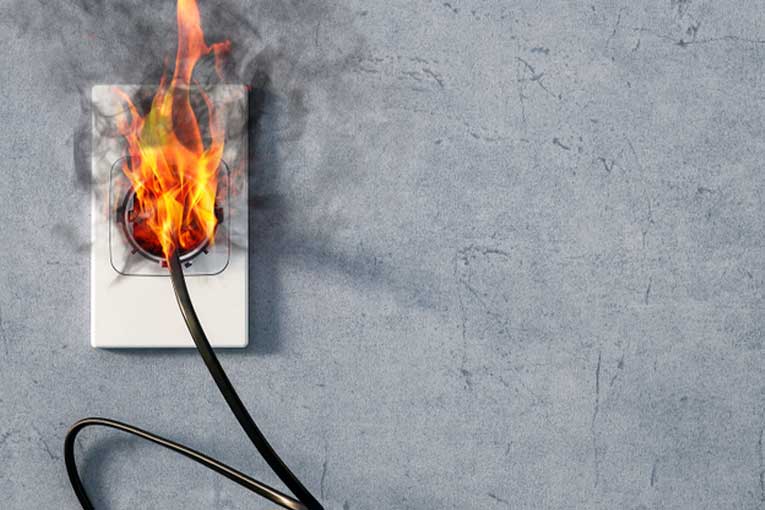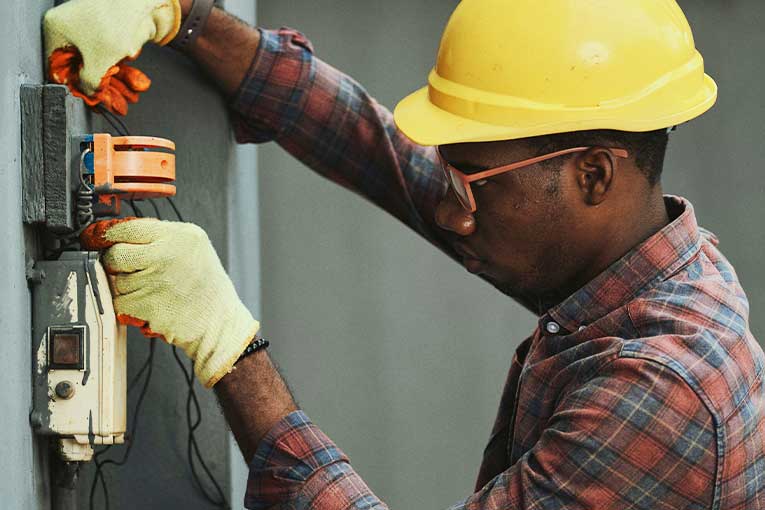How to Put Out an Electrical Fire
- February 1, 2024
- 8:00 am


Simon Burge
Share this content
Electrical fires are not only frightening but also pose a severe threat to life and property.
Understanding the dynamics of these fires and, more importantly, knowing how to respond is paramount for personal safety.
This article delves into the origins of electrical fires, provides practical insights into how to put out an electrical fire, and imparts crucial preventive measures.
Hopefully you’ll gain the knowledge needed to protect yourself, your loved ones, and your surroundings from the potentially devastating consequences of electrical hazards.
What Causes Electrical Fires?

Electrical fires can ignite from various sources, often stemming from issues within the electrical systems themselves.
Here’s a breakdown of the common causes:
Faulty Wiring
Old or improperly installed wiring is one of the most common causes of fire.
Frayed wires, loose connections, or overloaded outlets can create a spark, initiating a fire hazard.
Appliance Malfunctions
Defective appliances, especially those with damaged cords or internal faults, can be catalysts for electrical fires.
Overheating due to prolonged use or manufacturing defects can escalate the risk.
Outdated Electrical Systems
Ageing electrical systems, unable to meet the demands of modern appliances, are susceptible to overheating.
This can result in sparks, leading to potential fire outbreaks.
Overloaded Circuits
Plugging too many devices into a single circuit can overload it, causing overheating and sparks.
This is particularly prevalent in older homes with limited electrical capacity.
Power Strips and Extension Cords
Improper use of power strips and extension cords, such as daisy-chaining them or using them for high-wattage appliances, can lead to overheating and electrical fires.
Light Fixtures
Faulty light fixtures or incorrect wattage bulbs can generate excess heat, posing a risk of fire. Ensuring proper installation and using appropriate bulbs is essential.
Electrical Appliances Left On
Leaving electrical appliances on for extended periods, even when not in use, can result in overheating and potential fire hazards.
Infestations
Rodents chewing on electrical wiring can expose the conductors, leading to short circuits and the possibility of electrical fires.
Natural Disasters
Extreme weather events, such as lightning strikes or power surges during storms, can cause electrical fires by overwhelming the system.
Poor Electrical Maintenance
Neglecting regular electrical maintenance, including checking for wear and tear, loose connections, and outdated components, increases the likelihood of electrical fires.
Thermal Runaway
Thermal runaway is a phenomenon where a device’s temperature escalates uncontrollably, often leading to catastrophic consequences.
In electrical systems, it’s a potential precursor to fires.
If a component experiences thermal runaway, it can trigger a chain reaction, causing neighbouring components to heat up rapidly.
How to Put Out an Electrical Fire
Electrical fires demand swift action.
If you encounter an electrical fire, follow these steps:
Cut the Power

The initial and most critical action when dealing with an electrical fire is to sever its power source.
Find the fuse box and promptly turn off the electricity.
This action eliminates the fuel that sustains the fire.
Use a Fire Extinguisher
In the case of a small electrical fire, a Class C fire extinguisher is the appropriate tool.
Aim the extinguisher directly at the base of the flames and sweep from side to side.
This targeted application helps smother the fire without posing additional risks.
Never Use Water
Water and electricity don’t mix well.
Never attempt to use water to extinguish an electrical fire, as it can lead to electrocution and worsen the situation.
Instead, opt for a fire extinguisher designed specifically for electrical fires.
Smother the Flames
Employ a fire blanket or a heavy, non-flammable material to smother the flames.
Place the blanket over the fire to cut off its oxygen supply, a crucial element for combustion.
This method is effective for smaller fires on electrical equipment.
Evacuate and Call for Help
If the electrical fire persists or escalates beyond your control, prioritise your safety.
Immediately evacuate the premises, and from a safe distance, call the fire service.
Await professional assistance to handle the situation effectively.
Why Electrical Fires are so Dangerous
Electrical fires pose a significant threat due to their unique characteristics.
Here’s a closer look at why these fires are particularly hazardous:
Rapid Escalation
Electrical fires have a notorious reputation for escalating swiftly.
The high temperatures generated can cause surrounding materials to catch fire, leading to a rapid spread.
What begins as a small electrical malfunction can transform into a full-blown inferno within moments.
Toxic Fumes
The materials involved in electrical fires, such as wiring and appliances, release toxic fumes when ignited.
These fumes can include carbon monoxide and other harmful substances, posing severe health risks to occupants.
Inhaling these toxic gases can lead to respiratory issues, unconsciousness, and, in extreme cases, fatalities.
Structural Damage
Beyond the immediate flames, electrical fires can cause extensive structural damage.
The intense heat can compromise the integrity of wiring systems, insulation, and surrounding materials.
This damage not only causes costly repairs but also increases the risk of subsequent fires.
Risk of Electrocution
Attempting to extinguish an electrical fire with water can lead to a grave risk of electrocution.
Water conducts electricity, and using it on electrical fires can result in severe injuries or fatalities.
This unique hazard makes responding to electrical fires more complex and necessitates specialised firefighting measures.
Challenges for Firefighters
Firefighters face distinct challenges when tackling electrical fires.
The conductivity of electricity can interfere with standard firefighting methods, requiring specialised equipment.
Moreover, the potential for hidden pockets of fire within walls or electrical systems makes complete extinguishment more challenging.
Reignition Potential
Even after seemingly successful extinguishment, electrical fires can reignite.
This is often due to hidden smouldering embers or damaged wiring reigniting when power is restored.
Addressing this reignition potential requires thorough assessment and preventative measures.
What Type of Fire is an Electrical Fire?
Electrical fires fall under Class C fires.
Unlike other types of fire, they involve energised electrical equipment, making water a dangerous choice for extinguishing.
How to Prevent Electrical Fires
Electrical fires, with their potential for devastating consequences, underscore the importance of proactive preventive measures.
Here’s a detailed look at how you can significantly reduce the risk of electrical fires:
Regular Inspections and Maintenance

Regular inspections of your electrical systems are vital.
Ensure that wiring, outlets, and appliances are in good condition.
Any signs of wear, damage, or overheating should be promptly addressed.
Consider hiring a professional electrician for thorough inspections, especially in older properties.
Avoid Overloading Outlets
Overloading outlets is a common cause of electrical fires.
Distribute electrical loads evenly and avoid daisy-chaining multiple devices to a single outlet.
Invest in surge protectors to safeguard against power surges, which can also contribute to overheating.
Use Correct Wattage Bulbs
Incorrectly matched light bulb wattages can generate excessive heat, posing a fire risk.
Always use bulbs that match the recommended wattage for fixtures.
Check labels and replace bulbs promptly if they blow or flicker.
Replace Damaged Cords
Frayed or damaged electrical cords are hazardous.
Replace them immediately to avoid short circuits and potential fires.
When using extension cords, opt for high-quality ones designed for your specific needs and replace them if they show signs of wear.
Install Arc Fault Circuit Interrupters (AFCIs)
AFCIs detect dangerous electrical arcs, which can cause fires, and automatically shut off the circuit.
Consider installing AFCIs in your home, especially in bedrooms and living spaces.
They provide an additional layer of protection against electrical fires.
Keep Combustibles Away
Avoid placing flammable materials near electrical appliances and outlets.
Curtains, papers, and other combustibles should be kept away from heaters, appliances, and other devices that generate heat.
Professional Wiring for Appliances
Ensure that major appliances like stoves, refrigerators, and washing machines are installed by professionals.
Improper wiring or installation can lead to electrical faults and fires.
Upgrade Older Wiring
In older homes, outdated wiring systems may not meet current safety standards.
Consider upgrading to modern wiring, especially if you experience frequent electrical issues or if your home is more than a few decades old.
Educate Household Members
Educate all household members about electrical safety.
Teach them about the dangers of overloading circuits, the importance of reporting electrical issues promptly, and the proper use of appliances and electronic devices.
Emergency Planning
Include electrical fire safety in your overall emergency planning.
Ensure that all family members know how to respond to electrical fires, including the location of fire extinguishers and emergency exits.
Conclusion
This article should now give you the information on how to put out an electrical fire.
Knowing how to put out an electrical fire is essential, but prevention is key.
Prioritise electrical safety through regular maintenance, professional installations, and a quick response to warning signs.
Your proactive efforts can make a significant difference in keeping your home or workplace safe from electrical fire hazards.



